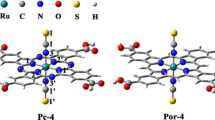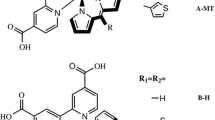Abstract
A variety of heteroleptic ruthenium sensitizers have been engineered and synthesized because of their higher light-harvesting efficiency and lower charge-recombination possibility than the well known homoleptic N3 dye. As such, a great deal of attention has been focused on sensitizers with the general formula Ru(ancillary-ligand)(anchoring-ligand)(NCS)2, among which important examples are Ru(4,4′-bis(5-hexylthiophen-2-yl)-2,2′-bipyridine)(4,4′-carboxylic acid-4′-2,2′-bipyridine)(NCS)2 (C101) and Ru(N-(4-butoxyphenyl)-N-2-pyridinyl-2-pyridinamine)(4,4′-carboxylic acid-4′-2,2′-bipyridine)(NCS)2 (J13). In order to simulate experimental conditions with different pH values, the photosensitizing processes of these sensitizers possessing different degrees of deprotonation (2H, 1H to 0H) have been explored theoretically in this work. Their ground/excited state geometries, electronic structures and spectroscopic properties are first calculated using density functional theory (DFT) and time-dependent DFT (TDDFT). The absorption and emission spectra of all the complexes in acetonitrile solution are also predicted at the TDDFT (B3LYP) level. The calculated results show that the ancillary ligand contributes to the molecular orbital (MO) energy levels and absorption transitions. It is intriguing to observe that the introduction of a thiophene group into the ancillary ligand leads directly to the increased energy of the absorption transitions in the 380–450 nm region. The calculations reveal that although deprotonation destabilizes the overall frontier MOs of the chromophores, it tends to exert a greater influence on the unoccupied orbitals than on the occupied orbitals. Consequently, an obvious blue shift was observed for the absorptions and emissions in going from 2H, 1H to 0H. Finally, the optimal degree of deprotonation for C101 and J13 has also been evaluated, which is expected to lead to further improvements in the performance of dye-sensitized solar cells (DSSCs) coated with such sensitizers.
Similar content being viewed by others
References
O’Regan B, Grätzel M. A low-cost, high-efficiency solar cell based on dye-sensitized colloidal TiO2 films. Nature, 1991, 353: 737–740
Hagfeldt A, Grätzel M. Molecular photovoltaics. Acc Chem Rev, 2000, 33: 269–277
Grätzel M. Photoelectrochemical cells. Nature, 2001, 414: 338–344
Kalyanasundaram K, Grätzel M. Applications of functionalized transition metal complexes in photonic and optoelectronic devices. Coord Chem Rev, 1998, 177: 347–414
Hara K, Sato T, Katoh R. Molecular design of coumarin dyes for efficient dye-sensitized solar cells. J Phys Chem B, 2003, 107: 597–606
Horiuchi T, Miura H, Sumioka K, Uchida S. High efficiency of dye-sensitized solar cells based on metal-free indoline dyes. J Am Chem Soc, 2004, 126: 12218–12219
Morandeira A, Boschloo G, Hagfeldt A, Hammarstrolm L. Photoinduced ultrafast dynamics of coumarin 343 sensitized p-type-nanostructured NiO films. J Phys Chem B, 2005, 109: 19403–19410
Ito S, Zakeeruddin SM, Humphry-Baker R. High-efficiency organic-dye-sensitized solar cells controlled by nanocrystalline-TiO2 electrode thickness. Adv Mater, 2006, 18: 1202–1205
Dong HQ, Zhao ZL, Wen HY, Li YY, Guo FF, Shen AJ, Pilger F, Lin C, Shi DL. Poly(ethylene glycol) conjugated nano-graphene oxide for photodynamic therapy. Sci China Chem, 2010, 53: 2265–2271
Kuciauskas D, Freund MS, Gray HB, Winkler JR, Lewis NS. Electron transfer dynamics in nanocrystalline titanium dioxide solar cells sensitized with ruthenium or osmium polypyridyl complexes. J Phys Chem B, 2001, 105: 392–403
Islam A, Sugihara H, Hara K, Singh LP, Katoh R, Yanagida M, Takahashi Y, Murata S, Arakawa H, Fujihashi G. Dye sensitization of nanocrystalline titanium dioxide with square planar platinum(II) diimine dithiolate complexes. Inorg Chem, 2001, 40: 5371–5380
Wang Q, Campbell WM, Bonfantani EE, Jolley KW, Officer DL. Efficient light harvesting by using green Zn-porphyrin-sensitized nanocrystalline TiO2 films. J Phys Chem B, 2005, 109: 15397–15409
Geary EAM, Yellowlees LJ, Jack LA, Oswald IDH. Synthesis, structure, and properties of [Pt(II)(diimine)(dithiolate)] dyes with 3,3′-, 4,4′-, and 5,5′-disubstituted bipyridyl: Applications in dye-sensitized solar cells. Inorg Chem, 2005, 44: 242–250
Nazzruddin MK, Kay A, Rodicio I, Humphry-Baker R. Conversion of light to electricity by cis-X2bis(2,2′-bipyridyl-4,4′-dicarboxylate) ruthenium(II) charge-transfer sensitizers (X = Cl−, Br−, I−, CN−, and SCN−) on nanocrystalline titanium dioxide electrodes. J Am Chem Soc, 1993, 115: 6382–6390
Nazeeruddin MK, Zakeeruddin SM, Humphry-Baker R, Jirousek M, Liska P. Acid-base equilibria of (2,2′-bipyridyl-4,4′-dicarboxylic acid) ruthenium(II) complexes and the effect of protonation on charge-transfer sensitization of nanocrystalline titania. Inorg Chem, 1999, 38: 6298–6305
Nazeeruddin MK, Pechy P, Renouard T, Zakeeruddin SM. Engineering of efficient panchromatic sensitizers for nanocrystalline TiO2-based solar cells. J Am Chem Soc, 2001, 123: 1613–1624
Komatsuzaki NO, Yanagida M, Funaki T, Kasuga K, Sayama K, Sugihara H. Near-IR dye-sensitized solar cells using a new type of ruthenium complexes having 2,6-bis(quinolin-2-yl)pyridine derivatives. Sol Energy Mater Sol Cells, 2011, 95: 310–314
Jang SR, Choi MJ, Vittal R, Kim KJ. Anchorage of N3 dye-linked polyacrylic acid to TiO2/electrolyte interface for improvement in the performance of a dye-sensitized solar cell. Sol Energy Mater Sol Cells, 2007, 91: 1209–1214
Wang P, Klein C, Humphry-Baker R, Zakeeruddin SM, Grätzel M. A high molar extinction coefficient sensitizer for stable dye-sensitized solar cells. J Am Chem Soc, 2005, 127: 808–809
Wang P, Klein C, Humphry-Baker R, Zakeeruddin SM, Grätzel M. Stable ⩽8% efficient nanocrystalline dye-sensitized solar cell based on an electrolyte of low volatility. Appl Phys Lett, 2005, 86: 123508–123511
Gao FF, Wang Y, Shi D, Zhang J, Wang M, Jing XY, Humphry-Baker R, Wang P, Zakeeruddin SM, Grätzel M. Enhance the optical absorptivity of nanocrystalline TiO2 film with high molar extinction coefficient ruthenium sensitizers for high performance dye-sensitized solar cells. J Am Chem Soc, 2008, 130: 10720–10728
Chen CY, Chen JG, Wu SJ, Li JY, Wu CG, Ho KC. Multifunctionalized ruthenium-based supersensitizers for highly efficient dye-sensitized solar cells. Angew Chem Int Ed, 2008, 47: 7342–7345
Kisserwan H, Ghaddar TH. Enhancement of photovoltaic performance of a novel dye, “T18”, with ketene thioacetal groups as electron donors for high efficiency dye-sensitized solar cells. Inorg Chim Acta, 2010, 363: 2409–2415
Shi D, Pootrakulchote N, Li R, Guo J, Wang Y, Zakeeruddin SM, Grätzel M, Wang P. New efficiency records for stable dye-sensitized solar cells with low-volatility and ionic liquid electrolytes. J Phys Chem C, 2008, 112: 17046–17050
Jin ZZ, Masuda H, Yamanaka N, Minami M, Nakamura T, Nishikitani Y. Efficient electron transfer ruthenium sensitizers for dye-sensitized solar cells. J Phys Chem C, 2009, 113: 2618–2623
Jin ZZ, Masuda H. Triarylamine-functionalized ruthenium dyes for efficient dye-sensitized solar cells. ChemSusChem, 2008, 1: 901–904
Yan SG, Hupp JT. Semiconductor-based interfacial electron-transfer reactivity: Decoupling kinetics from ph-dependent band energetics in a dye-sensitized titanium dioxide/aqueous solution system. J Phys Chem, 1996, 100: 6867–6870
Gerisher H. Neglected problems in the pH dependence of the flatband potential of semiconducting oxides and semiconductors covered with oxide layers. Electrochim Acta, 1989, 34: 1005–1009
Nazeeruddin MK, Angelis FD, Fantacci S, Selloni A, Viscardi G, Liska P, Ito S, Taleru B, Grätzel M. Combined experimental and DFT-TDDFT computational study of photoelectrochemical cell ruthenium sensitizers. J Am Chem Soc, 2005, 127: 16835–16847
Bisquert J, Cahen D, Hodes G, Ruehle S, Zaban A. Physical chemical principles of photovoltaic conversion with nanoparticulate, mesoporous dye-sensitized solar cells. J Phys Chem B, 2004, 108: 8106–8118
Nazeeruddin MK, Humphry-Baker R, Liska P, Grätzel M. Investigation of sensitizer adsorption and the influence of protons on current and voltage of a dye-sensitized nanocrystalline TiO2 Solar Cell. J Phys Chem B, 2003, 127: 8981–8987
Su R, Xue WD, Feng Y, Wang JH, Yi D. Sensitization mechanism of tris(8-hydroxyquinoline)iron(III) on TiO2 anatase (101) surface. Acta Phys-Chim Sin, 2009, 25: 947–952
Ardo S, Meyer GJ. Photodriven heterogeneous charge transfer with transition-metal compounds anchored to TiO2 semiconductor surfaces. Chem Soc Rev, 2009, 38: 115–164
Becke AD. Density-functional thermochemistry. III. The role of exact exchange. Chem Phys, 1993, 98: 5648–5652
Yang Y, Bai FQ, Zhang HX, Zhou X, Sun CC. Theoretical studies on structures and spectroscopic properties of a series of heteroleptic iridium complexes based on tridentate bis(benzimidazolyl)pyridine ligand. Comput Theoret Chem, 2011, 963: 298–305
Casida ME, Jamorski C, Casida KC, Salahub DR. Molecular excitation energies to high-lying bound states from time-dependent density-functional response theory: Characterization and correction of the time-dependent local density approximation ionization threshold. J Chem Phys, 1998, 108: 4439–4449
Stratmann RE, Scuseria GE. An efficient implementation of time-dependent density-functional theory for the calculation of excitation energies of large molecules. J Chem Phys, 1998, 109: 8218–8224
Matsuzawa NN, Ishitani A. Time-dependent density functional theory calculations of photoabsorption spectra in the vacuum ultraviolet region. J Phys Chem A, 2001, 105: 4953–4962
Barone V, Cossi M. Quantum calculation of molecular energies and energy gradients in solution by a conductor solvent model. J Phys Chem A, 1998, 102: 1995–2001
Cossi M, Rega N, Scalmani G, Barone V. Energies, structures, and electronic properties of molecules in solution with the CPCM solvation model. J Comput Chem, 2003, 24: 669–681
Bauernschmitt R, Ahlrichs R. Treatment of electronic excitations within the adiabatic approximation of time dependent density functional theory. Chem Phys Lett, 1996, 256: 454–464
Rosa A, Baerends EJ, Gisbergen SJ. Electronic spectra of M(CO)6 (M = Cr, Mo, W) revisited by a relativistic TDDFT Approach. J Am Chem Soc, 1999, 121: 10356–10365
Li MX, Zhou X, Xia BH, Zhang HX, Pan QJ, Liu T, Fu HG, Sun CC. Theoretical studies on structures and spectroscopic properties of photoelectrochemical cell ruthenium sensitizers, [Ru(Hmtcterpy) (NCS)3]n− (m = 0, 1, 2, and 3; n = 4, 3, 2, and 1). Inorg Chem 2008; 47: 2312–24
Wadt WR, Hay PJ. Ab initio effective core potentials for molecular calculations. Potentials for main group elements Na to Bi. J Chem Phys, 1985, 82: 284–298
Hay PJ, Wadt WR. Ab initio effective core potentials for molecular calculations. Potentials for K to Au including the outermost core orbitals. J Chem Phys, 1985, 82: 299–310
Frisch MJ, Trucks GW, Schlegel HB, Scuseria GE, Robb MA, Cheeseman JR, Scalmani G, Barone V, Mennucci B, Petersson GA, Nakatsuji H, Caricato M, Li X, Hratchian HP, Izmaylov AF, Bloino J, Zheng G, Sonnenberg JL, Hada M, Ehara M, Toyota K, Fukuda R, Hasegawa J, Ishida M, Nakajima T, Honda Y, Kitao O, Nakai H, Vreven T, Montgomery Jr. JA, Peralta JE, Ogliaro F, Bearpark M, Heyd JJ, Brothers E, Kudin KN, Staroverov VN, Kobayashi R, Normand J, Raghavachari K, Rendell A, Burant JC, Iyengar SS, Tomasi J, Cossi M, Rega N, Millam NJ, Klene M, Knox JE, Cross JB, Bakken V, Adamo C, Jaramillo J, Gomperts R, Stratmann RE, Yazyev O, Austin AJ, Cammi R, Pomelli C, Ochterski JW, Martin RL, Morokuma K, Zakrzewski VG, Voth GA, Salvador P, Dannenberg JJ, Dapprich S, Daniels AD, Farkas Ö, Foresman JB, Ortiz JV, Cioslowski J, Fox DJ, Gaussian09, Revision B.02, Gaussian, Inc., Wallingford CT, 2009
Chatt J, Duncanson LA. Olefin co-ordination compounds. Part III. Infra-red spectra and structure: Attempted preparation of acetylene complexes. J Chem Soc, 1953, 2939–2947
Boulet P, Chermette H, Daul C, Gilardoni F, Rogemond F, Weber J, Zuber G. Absorption spectra of several metal complexes revisited by the time-dependent density-functional theory-response theory formalism. J Phys Chem A, 2001, 105: 885–894
Monat JE, Rodriguez JH, McCusker JK. Ground- and excited-state electronic structures of the solar cell sensitizer bis (4,4′-dicarboxylato-2,2′-bipyridine)bis(isothiocyanato) ruthenium(II). J Phys Chem A, 2002, 106: 7399–7406
Fantacci S, Angelis FD, Selloni A. Absorption spectrum and solvatochromism of the [Ru(4,4′-COOH-2,2′-bpy)2(NCS)2] molecular dye by time dependent density functional theory. J Am Chem Soc, 2003, 125: 4381–4387
Barolo C, Nazeeruddin MK, Fantacci S, Censo DD, Comte P, Liska P, Viscard G, Quagliotto P, Angelis FD, Ito S, Grätzel M. Synthesis, characterization, and DFT-TDDFT computational study of a ruthenium complex containing a functionalized tetradentate ligand. Inorg Chem, 2006, 45: 4642–4653
Angelis FD, Fantacci S, Selloni A. Time-dependent density functional theory study of the absorption spectrum of [Ru (4,4′-COOH-2,2′-bpy)2(NCS)2] in water solution: Influence of the pH. Chem Phys Lett, 2004, 389: 204–208
Author information
Authors and Affiliations
Corresponding authors
Electronic supplementary material
Rights and permissions
About this article
Cite this article
Chen, J., Bai, F., Wang, J. et al. Theoretical studies of the structures and spectroscopic properties of the photoelectrochemical cell ruthenium sensitizers, C101 and J13. Sci. China Chem. 55, 398–408 (2012). https://doi.org/10.1007/s11426-011-4483-8
Received:
Accepted:
Published:
Issue Date:
DOI: https://doi.org/10.1007/s11426-011-4483-8




